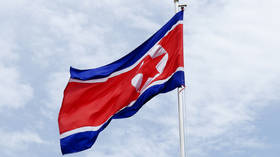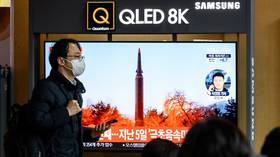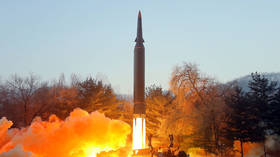North Korea flexes its military muscle again. What's it up to?

Kim Jong-un’s strategy behind carrying out two hypersonic missile tests carries a high-stakes message for the Biden administration.
North Korea has started 2022 with a bang, literally. Within the space of a week, Pyongyang has carried two hypersonic missile tests in the East Sea, one of them observed by Kim Jong-un personally – an ominous warning for those who understand the Democratic People's Republic of Korea’s (DPRK) messaging.
The tests come in the same period as Kim stating he would boost the country's defense capabilities amid “growing instability” on the peninsula at a key party meeting which marked 10 years of his formal ascension to power following the death of his father Kim Jong-il.
Observing the new test, Kim also called for the strengthening of “strategic military muscle, both in quality and quantity.” The sudden shift in mood is a blow to the attempts by outgoing South Korean leader Moon Jae-in to forge a deal to “end the Korean war.” Pyongyang is snubbing these moves, and sending an explicit message to the Biden administration, which has for the time being not made the North Korean issue a priority.
If it wasn't clear already, and it's been slowly yet progressively building up for a while, North Korea is now deliberately upping the stakes and, despite a poor economic situation, doubling down on advancing its military capabilities.
After a window of peaceful overture towards the Biden administration was largely left unanswered through most of 2021, Kim is now hardening his rhetoric and placing increased emphasis on military-based messaging.
This is classic North Korean strategy – capitalizing on the US-China divide for maximum strategic gain, and increasing provocations in an attempt to bait the United States into a crisis and force them to negotiate on Pyongyang’s terms.
The ability of the country to so quickly pass into the field of hypersonic missile technology, seemingly bypassing what America has itself, is also a reminder that the DPRK should not be underestimated, even with little going for it economically.
North Korea, as with all communist states, displays its political agenda and engages in indirect diplomatic messaging, both at home and abroad, through coordinated hierarchical state signaling and ‘gestures’. A common theme in how this works is to observe not only the rhetoric of the leader, but also the publicized visits and activities he undertakes, which are deliberately staged in order to signal the highest priorities. For example, when Xi Jinping visited a Chinese Air Force base in Guizhou last year, the geography of that location (near Taiwan) was chosen to send an obvious indirect message regarding Taiwan.
Likewise, in the DPRK, the things the supreme leader does are never random or without purpose, but in each instance a deliberative process of political messaging and agenda setting at the highest level. When Kim Jong-un was publicly emphasizing the poor state of the economy last year, this was, in fact, a peace overture that the DPRK was seeking negotiations, aid, and sanctions relief, whilst relegating at that time more hostile messaging from other senior figures, such as his sister Kim Yo-jong. Last year, he also visited the DPRK-China friendship monument on the 100th anniversary of the Chinese Communist Party, emphasizing friendship with Beijing. Therefore, when state media begins to directly publicize Kim's attendance at missile tests (which he does not always do), it should be obvious where he is now shifting his political priorities.
Why is this happening? Mostly because Pyongyang’s overtures for dialogue have been ignored by America. The DPRK rode out 2020 and 2021 cautiously, largely because it sought to wait out the Trump administration and then make overtures to the new Biden administration.
The Covid-19 pandemic, to which the country responded by shutting itself off from the outside world, also played a role. But during that time, North Korea's resolve has started to harden, as it has become clear to it that the US has little interest in playing ball and negotiating. Biden is focusing on China, and the new geopolitical environment in Washington against Beijing has also changed North Korea's cost-benefit calculus.
While in past years China was more willing to cooperate with Washington in imposing tough sanctions on Pyongyang, this environment no longer exists, and the DPRK's strategic importance to Beijing has consolidated, making the Chinese even more risk-averse to taking action against the DPRK. As this has happened, Pyongyang has sensed that, as during the pre-1991 Cold War – where it played off China and the USSR – its hand has increased and therefore it is more likely to create disruption and suffer penalties, with the long-term role of extracting benefits for itself.
China's cooperation on sanctions against North Korea in 2017 was prior to the full reorientation of US foreign policy against China. The UN security council is now divided on North Korea and is unable to produce joint statements condemning it anymore.
So, despite the country's desperately struggling economy, Kim now believes he has a stronger hand to win concessions from all parties by further advancing North Korea's nuclear and ballistic missile capabilities, aiming to reel in America's attention and ultimately face few consequences for it. In a word, it is a ‘nothing to lose’, or ‘win-win’, posture and this is setting the tone for this year. Pyongyang is not interested in Seoul's peace gestures because it does not see any serious concessions coming from them from the US. It also has no interest in abandoning its nuclear program and is gearing up to deal and bargain hard with whosoever will become Moon's successor in Seoul from March, leaving his peace overtures and legacy in ruins.
But, by demonstrating its hypersonic capabilities – something the US has not yet developed itself – Pyongyang shows determination and intent, finding new and surprising ways to stay in the peninsula arms race and make itself a dangerous opponent.
It is very much classic North Korea that, even when enduring a damaging economic crisis with dire consequences for its population, it strives to engage in a long-term strategic struggle to seek to win on its own terms.
The White House has stubbornly stuck to its “complete denuclearization” line, but it isn’t happening, and in the long run, the consequences of an increasingly capable DPRK may come back to haunt it. The stage is set now, but just how far will Pyongyang go to push for America's attention? Might it carry out nuclear or ICBM tests again? It would be wise not to avert one's eyes from this tinderbox region in 2022.
The statements, views and opinions expressed in this column are solely those of the author and do not necessarily represent those of RT.
















